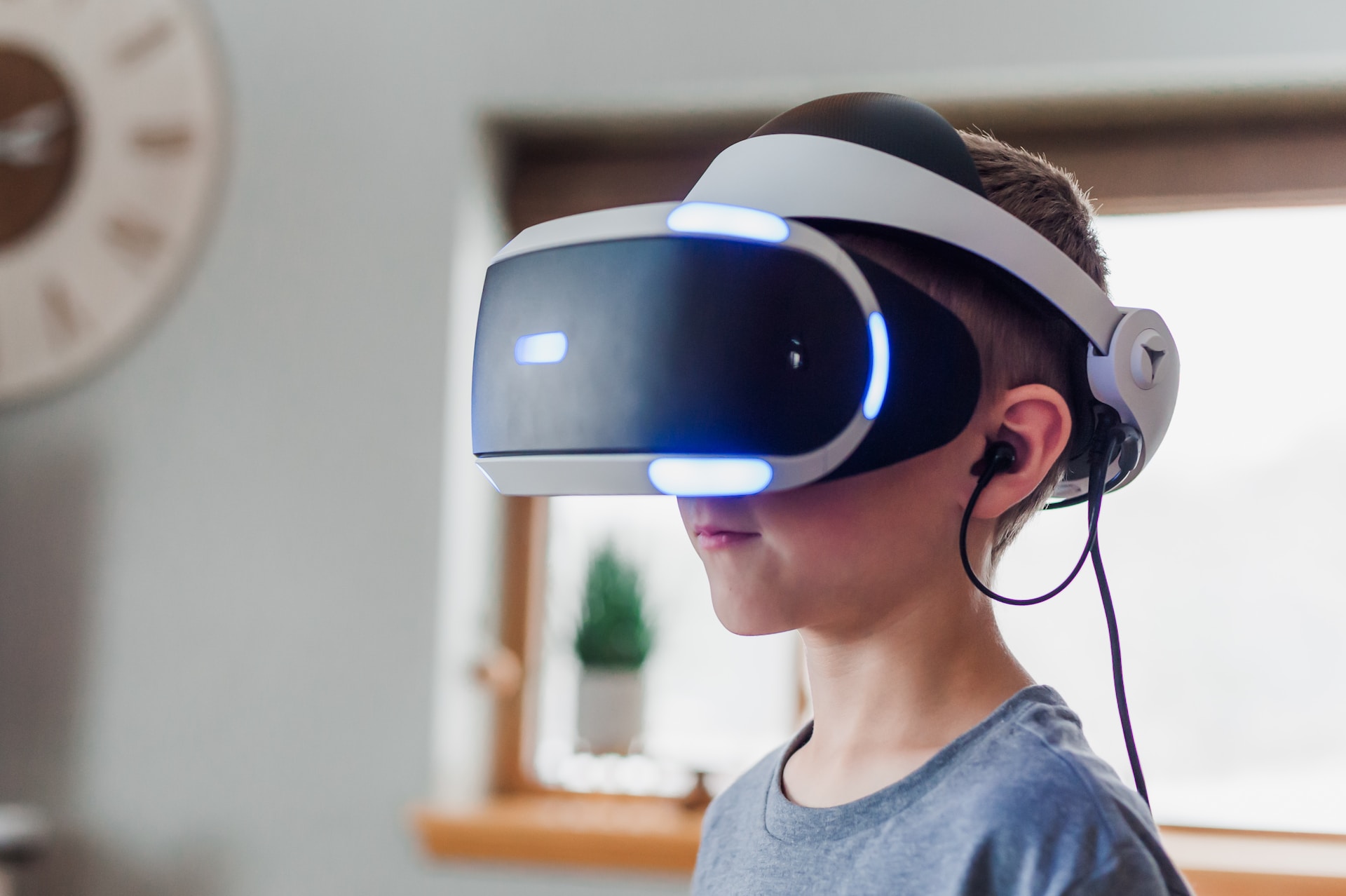Welcome to the world of VR, where the possibilities are endless! Gone are the days when we needed a physical reality to experience all the amazing things life has to offer. Now, with Virtual Reality, you can explore new and exciting worlds from the comfort of your own home! Come join us as we dive into the world of VR and explore what it has to offer.
Introduction to Virtual Reality
Virtual reality (VR) is a rapidly growing technology that gives users an immersive, computer-generated environment to explore and interact with. VR devices employ sensors, such as accelerometers and gyroscopes, to track a personÕs movements so they can move freely within a virtual situation. The latest generation of these headsets are equipped with built-in cameras and displays, allowing the user’s view of the virtual world to match their physical movements.
Although there were attempts in the past to create realistic VR simulations, recent advancements in technology have made modern VR experiences much more immersive. This combination of display and tracking has given popular headsets like the HTC Vive, Oculus Rift and PlayStation VR unprecedented amounts of functionality. Various types of handheld control pads are available for each system that allow users to interact with their environment or manipulate objects like they would in real life.
Besides gaming, virtual reality is also being used in educational and therapeutic settings due to its impressive capabilities at creating convincing digital landscapes. Recent research suggests that these increasingly realistic visuals can help trigger areas of our brains normally only stimulated by actual real-world situations; meaning that educational tours or psychological simulations are now possible at home.
History of Virtual Reality
Virtual Reality (VR) has been around since the mid-20th century, although its definition has evolved greatly over time. In its most basic form, VR is an artificial world created for entertainment purposes. It was initially used to control or manipulate a virtual environment through devices such as gloves, 3D goggles, and other peripherals.
Over the years, advances in technology have allowed for more applications and uses of VR. The concept of immersive technology emerged in the early 1990s and saw the first hi-tech virtual reality headsets being released in 1995. These headsets provided an immersive experience with 3D graphics and 360¡ views of simulated environments. This was followed by further advancements in technology that allowed for more realistic visuals with higher resolution and improved audio quality.
In recent times, VR has seen a resurgence in popularity due to its integration into gaming systems such as Playstation VR, Oculus Rift, HTC Vive, etc., which offer users an even more realistic experience with highly detailed visuals and responsive controls. These gaming systems are popular among both casual gamers and hardcore fans alike who can now fully immerse themselves into a virtual world without having to leave their own home! Apart from gaming experiences, business applications are also becoming increasingly popular due to their ability to simulate real-world scenarios for education or training purposes. With all these developments taking place in the field of virtual reality, it looks set to continue growing at an exponential rate going forward!
Types of Virtual Reality
Virtual Reality (VR) is an artificial environment created with the help of software and presented to users in such a way that they are able to interact with objects and spaces. It provides users with a sense of immersion due to its realistic graphics, sound, movement, and touch capabilities.
There are four main types of virtual reality experiences:
1. Desktop Virtual Reality is experienced through the use of a keyboard and mouse on a user’s computer while wearing a head-mounted display (HMD). A headset is typically used in this type of VR experience to provide the necessary viewing capability.
2. Room-Scale Virtual Reality is experienced by using within or near a set physical space that has been configured for location-based tracking cameras or sensors to track your motions as you navigate within it. The environment can be adjusted as needed for optimal experiences.
3. Standing Virtual Reality is similar to Room-Scale VR but doesnÕt involve walking around or standing up so you can be seated or standing still while navigating the experience. This type of experience will allow for enhanced subtle movements without sacrificing navigation range within the environment.
4. Immersive Virtual Reality utilizes all sense inputs for maximum impact Ð sight, sound, smell, touch, taste Ð creating more life-like scenarios than can ever be achieved with just visuals alone. The technology behind creating this type of experience ranges from motion capture hardware through sophisticated head mounted displays (HMD) designed specifically for virtual reality simulations and omnidirectional treadmills that allow users to move freely while remaining in one place safely during the simulation rather than having them move around physically in space as they do in Room Scale VR experiences
Benefits of Virtual Reality
Virtual Reality (VR) is an immersive experience utilizing computer technology to simulate a realistic environment. It is becoming increasingly popular in entertainment, education, and business, and its user base continues to grow exponentially. The benefits of Virtual Reality are numerous and range from enhanced creativity to improved productivity.
In entertainment, Virtual Reality can be used to create completely immersive gaming experiences where users interact with their environment as if in real life. In addition, VR can provide unique learning opportunities as well as innovative applications such as virtual tours or allowing users to pursue new activities in a safe environment or explore points of view that would otherwise require a physical journey.
VR also has potential applications for businesses allowing for better customer service experiences, more efficient processes, enhanced training tools and more streamlined staff interactions. Employees can benefit from virtual customer communication simulations and look at production from another angle without having to take the time out of their regular duties.
With current advances in technology being made daily, the possibilities of what can be done through use of Virtual Reality continue to expand and improve. This combined with the ever decreasing cost makes VR an incredibly attractive tool for businesses everywhere that are looking for ways to reduce cost while increasing efficiency simultaneously.
Challenges of Virtual Reality
Virtual Reality (VR) technology promises to revolutionize the way people interact with machines and digital content. However, numerous technical and psychological challenges remain before the vision of experiencing digital content in a fully immersive environment can be realized. On the technical side, latency, jittering artifacts and physical/mental discomfort remain common issues which must be addressed. On the psychological side, concerns range from user disorientation in unfamiliar environments to legal implications of users experiencing assaultive behavior within VR worlds. In both cases, technology research is needed to identify design solutions that address usability issues while providing a positive virtual experience for users. This research must include user-testing to ensure that design solutions are appropriately tailored to meet real-world needs.
Applications of Virtual Reality
Virtual reality (VR) is a computer technology that creates simulated environments, allowing users to experience three-dimensional images and sound through an immersive headset. VR can be used for a variety of purposes, such as gaming, education, communication and entertainment.
There are multiple applications of VR appearing across industries. Following are some of the most notable applications:
1. Gaming Ð VR enables gamers to interact with virtual worlds like never before. Players can immerse themselves in highly detailed scenes with full control over their actions. From thrilling first-person shooter games to exploring distant galaxies, anything is possible when you play in the virtual world.
2. Healthcare Ð Healthcare professionals use VR for diagnosis and intervention of mental health disorders; surgeons for performing complex surgeries on virtual organs instead of humans; physical therapists for training patients how to move after an accident or injury; and psychologists for creating scenarios that can help patients confront fear or anxiety issues in a controlled setting.
3. Education Ð VR can make learning more interesting by taking students out from behind books and into ancient historical sites or places far away from home so they can experience first-hand what they’re studying in school. Educational institutions use this technology to create compelling educational experiences that motivate students to learn more about a certain topic or subject matter through interactive activities designed using photo-realistic 3D models and avatars featuring powerful AI capabilities
4. Designing new products – Companies have been utilizing the power of virtual reality in product designing since long before it was mainstreamed Ñ utilizing powerful modeling software that could render complete photorealistic shapes and forms into computer-generated 3D images using just simple code commands was available since early 1990s but until now it was limited only to certain industries in various capacities due its cost barrier being high until recently when the prices started becoming much lower making this technology much more accessible for wider range of people and businesses alike
6 Travel & Tourism – Industry players such as hotels, travel agencies, airlines etc., have started introducing online applications powered by 360¡ panoramic visuals showing their properties along with picturesque views their destinations offer in order to attract customers looking for vacation packages online instead relying completely on paper booklet brochures which had become very outdated way presenting information about any kind business related products
Future of Virtual Reality
Virtual Reality (VR) technology has experienced a recent surge in popularity and is quickly becoming an integral part of our lives. VR has been used across a range of different industries, from gaming to healthcare, education, and beyond. It is being used to recreate wildlife experiences, train medical professionals, explore outer space, or even just for entertainment purposes. The possibilities this technology offers seem almost limitless, and the future of virtual reality looks brighter than ever before.
As the popularity of VR continues to grow, the industry is constantly innovating new ways for people to interact with the technology. Technologies such as Augmented Reality (AR) and Mixed Reality (MR) are combining with VR to create new immersive experiences that blur the line between physical and digital objects. This combination of technologies will allow us to create more believable and powerful experiences than ever before.
In addition to this ongoing innovation in technology and experience design, virtual reality’s potential impact also grows with computing power. As computers become more powerful they are capable of rendering larger environments in astounding detail at higher fidelity than ever before possible. This means that not only can users expect more realistic visuals but also that these visuals will require less technical resources to generate them; optimizing gaming performance while still enabling believable world-building simultaneously.
Finally, future developments may not be restricted solely on hardware innovations but could focus on biological interfaces like sensors that measure changes in brain activity or utilize eye-tracking data or embedded implants like augmented reality contact lenses or neural-links which connect devices directly with brains, allowing users to control them using only their thoughts or emotions as input signals . With these potential advancements in mind, itÕs easy to see how far virtual reality can extend its reach into everyday life everywhere from home-based entertainment systems like the Oculus Rift S all the way up through commercial solutions for enterprise applications and beyond for use within many industries including healthcare & finance
Conclusion
In conclusion, virtual reality technology is a rapidly growing field in computer science and engineering that provides immersive visual experiences for its users. It can be used for entertainment, recreation or professional applications such as educational programs, medical training and military simulations. Although the hardware required for virtual reality is currently quite expensive, it is expected to become much more affordable in the near future. With these advances, virtual reality has potential to revolutionize the way humans interact with digital environments and revolutionize gaming, education and other aspects of our lives.






